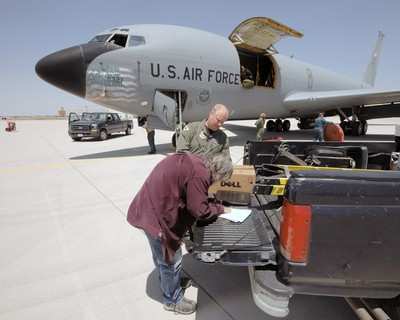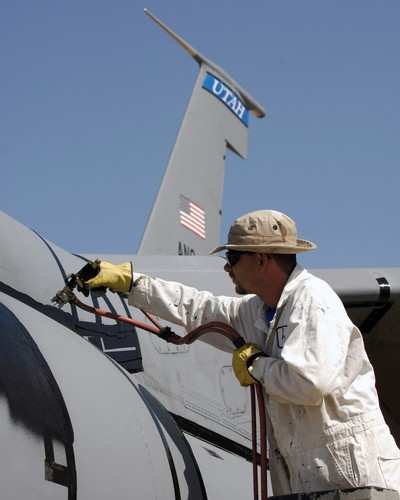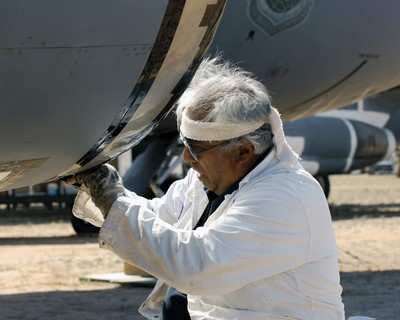Only One KC-135E Left In Utah ANG Fleet
One of only two remaining KC-135E-model Stratotankers of the
Utah Air National Guard was delivered to its final resting place
April 24 to officials of the 309th Aerospace Maintenance and
Regeneration Group at Davis-Monthan Air Force Base.

The aircraft touched down onto the Arizona flightline, its
maintenance and service records were signed over to a 309th AMARG
official, and the aircraft was prepped for induction into what has
to be considered aircraft heaven, otherwise known as the
"boneyard."
The "boneyard" is a 2,600 acre facility that got its start in
1946 storing World War II bombers and cargo planes, and has since
grown into a modern, high-tech industrial organization managing an
inventory of more than 4,460 aircraft, 29 aerospace vehicles and
350,000 line items of aircraft production tooling. The group's
services include aircraft storage and disposition, parts
reclamation and restoration to flight-level maintenance.
However, the fact that these aircraft will be stored provides
little solace for those who flew them. "This day may not mean much
to some, but I have personally been flying that aircraft since
1983," said Col. Kelvin Findlay, the Utah Air National Guard's
151st Air Refueling Wing commander. "You become attached to an
aircraft with such an impressive track record. It literally becomes
a friend."
Tail number 60-0327 rolled off the Boeing assembly plant in
1960, originally serving the active Air Force and then the 191st
Air Refueling Squadron of the Utah Air National Guard.

"The E-model modification was a far-sighted and cost-effective
decision by the Air National Guard," said Col. Ron Blunck, the
151st Maintenance Group commander who served as both an enlisted
crew chief and later a master navigator aboard the KC-135. "The
E-model's performance was a vast leap forward from the A-model, and
was a workhorse for the ANG for over 20 years. We could carry
heavier fuel loads, and could stop on very short runways with the
reverse thrust. The E-model was a very capable aircraft and would
still be viable today, but the engines are no longer
supportable."
It was this configuration that the Utah Air National Guard flew
for more than 20 years, supporting the Cold War, operations Desert
Shield and Desert Storm, operations Deny Flight, Decisive Endeavor
and Joint Forge in the Balkans, Operation Noble Eagle, Operation
Enduring Freedom and Operation Iraqi Freedom.
After long service with the Guard and Reserve, the E-model
variants of the KC-135 aircraft's days have come to a close. In
October of 2005, officials of the 151st ARW received the first of
its eight KC-135R aircraft. The re-engined aircraft uses the same
airframe as it's A-model predecessors, but can offload more fuel,
is more fuel efficient and much quieter than the KC-135E.
"Our maintainers received our R-models with mixed feelings,
having to say good-bye to some good old friends," Colonel Blunck
said. "I have nearly 4,000 hours in the E-model and I will always
have many fond memories of the aircraft."

Though a contract has just recently been awarded to produce the
KC-45A, the Air Force's newest long-range refueling and cargo
platform, the KC-135R may soar into the wild blue yonder through
the year 2025.
(Aero-News salutes Master Sgt. Burke Baker, 151st Air
Refueling Wing Public Affairs)
 ANN's Daily Aero-Linx (05.02.24)
ANN's Daily Aero-Linx (05.02.24) ANN's Daily Aero-Term (05.02.24): Touchdown Zone Lighting
ANN's Daily Aero-Term (05.02.24): Touchdown Zone Lighting Aero-News: Quote of the Day (05.02.24)
Aero-News: Quote of the Day (05.02.24) ANN FAQ: Contributing To Aero-TV
ANN FAQ: Contributing To Aero-TV NTSB Final Report: Cirrus Design Corp SR20
NTSB Final Report: Cirrus Design Corp SR20





